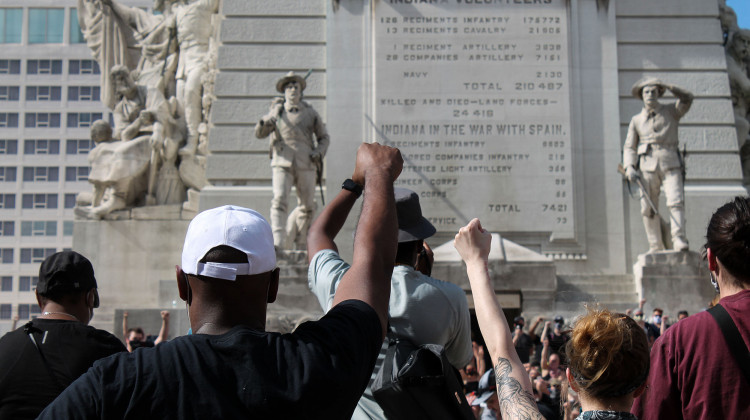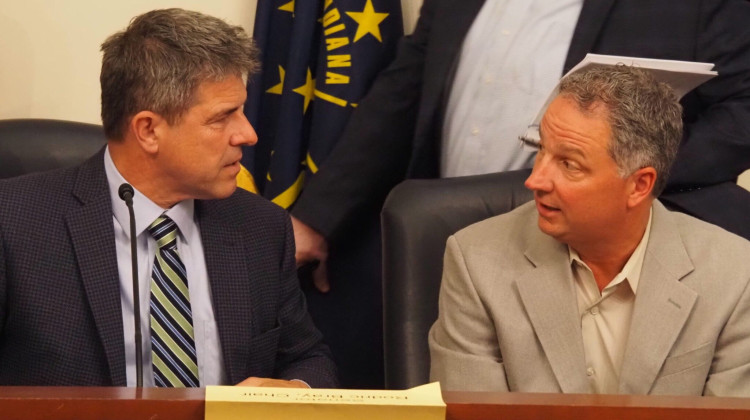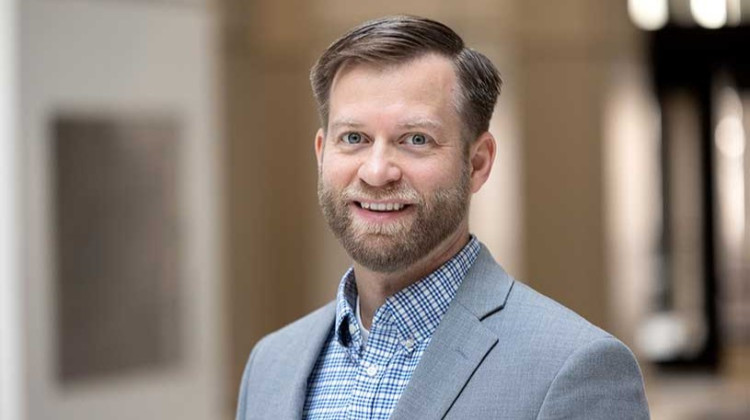
Many of the protests in Indianapolis have focused on justice for Dreasjon “Sean” Reed. Police shot and killed him after he ran from Indianapolis police following a car chase on May 6.
Lauren Chapman/IPB NewsProtesters continue to march against police violence in cities across Indiana. Indianapolis and Fort Wayne’s protests over the weekend resulted in police confrontation and vandalism. South Bend’s protest went largely without police intervention.
Indy 10 Black Lives Matter’s Jessica Louise, South Bend Black Lives Matter’s Jorden Giger, and Fort Wayne organizer Daylana Saunders discuss the week of protests and the demands for change.
“We’ve seen overall the demonstrations across the country with white citizens, going in to the statehouse, going up to the governor’s mansion and protesting not being able to get a haircut,” Louise says. “We are literally begging and pleading and advocating for our residents not to be killed. And for the police to be held accountable.”
Both South Bend and Indianapolis have had officer-involved shootings fairly recently.
Many of the protests in Indianapolis have focused on justice for Dreasjon “Sean” Reed. Police shot and killed him after he ran from Indianapolis police following a car chase on May 6. The 21-year-old was live streaming on Facebook while thousands of people watched as he was killed on the city's northwest side. The Indianapolis Metropolitan Police Department says they fired a taser that appeared to be ineffective and that gunshots were exchanged.
Reed has become a focal point for Indianapolis protesters who took to the streets starting last Friday, sparked by the death of George Floyd who was killed by a white Minneapolis officer on May 25. Reed's name is often chanted during marches. His name is spray painted on buildings throughout downtown.
READ MORE: Mother Asks Feds To Investigate IMPD Killing Of Dreasjon Reed
The same night Reed died, two others – including a pregnant woman – were killed by Indianapolis Metropolitan Police Department officers.
“The officer involved in striking and killing the pregnant woman and her unborn child was named mere hours later,” Louise says. “We still do not have a name for the officer who shot and killed Dreasjon.”
Reed’s death was the most recent officer-involved shooting death in Indianapolis. In June 2017, Aaron Bailey was shot to death after officers pulled him over. He hadn’t used a signal when changing lanes. Officer Carlton Howard ran his plates, discovering he had an expired license. After becoming nervous and attempting to drive away, Bailey crashed his vehicle. After the crash, Officers Howard and Michael Dinnsen saw Bailey rummaging near the center console and shot him four times.
Special Prosecutor Kenneth Cotter determined there wasn’t sufficient evidence to refute the officers’ fear of injury or death by Bailey, and decided criminal charges weren’t appropriate. A federal investigation into Bailey’s death also declined to bring charges.
A months-long internal investigation allowed both officers to keep their jobs.
“This is, unfortunately, [mass protests] feels like it’s been a long time coming,” Lousie says. “It has been years of police violence and brutality and misconduct by the city of Indianapolis’s police force. And people are tired of it.”
The beginning of this Facebook Live experienced some technical difficulty.
In South Bend, the shooting death of Eric Logan became national news during former Mayor Pete Buttigieg’s run for the Democratic presidential nomination.
Just before 3:30 a.m. on Father’s Day 2019, South Bend police officer Ryan O’Neill responded to a call about a suspicious person at an apartment building.
Prosecutors say when O’Neill found Eric Logan stepping out of a car, he had an eight-and-a-half-inch knife raised in one hand and a purse tucked into his waistband. Then O’Neill yelled several times for Logan to drop the knife before firing two shots, one into his stomach.
“Since last year, we have been protesting and issuing demands and organizing around those demands, pretty much every day since he was murdered,” says Giger.
What are some of the demands from organizers in light of these deaths?
In Indianapolis:
Name, fire, and bring charges against the officer who killed Dreasjon Reed
“We prepared to see the case of Dreasjon Reed from beginning to end,” Louise says. “Working with the family, highlighting and amplifying their demands, making sure people aren’t leveraging this dead child’s name in order to push their own agenda.”
IMPD said Reed exchanged gunfire with officers. Attorneys representing Reed’s family say they have collected evidence that proves Reed did not shoot at the police.
The family’s attorney, Swaray Conteh, filed a court motion Sunday for the name of the officer who shot Reed to be released. Conteh also wants the names of all police officers at the scene, West 62nd Street and North Michigan Road, within 30 minutes of the shooting, and the name of the officer heard on the Facebook live stream making a comment about Reed's body after the fatal shooting.
The police department suspended the officer who made the comment. On Thursday, a Marion Superior Court judge named a special prosecutor to investigate Reed’s death.
Use-Of-Force Review Board must include citizen input
Mayor Joe Hogsett has promised the Use-Of-Force Review Board since 2018, but Louise has concerns about what that looks like. It’s designed to replace the Firearm Review Board.
“Under the Firearm Review Board, they failed to review 19 police shootings that occurred in two years under three police chiefs,” Louise says. “Of 19 of those shootings, six of them were fatal.”
She says including citizen input requires citizens to be on that board – not just open to public comment.
In South Bend:
Creation of a Civilian Review Board
Giger says a recently elected city-council member has put forward legislation to create that review board. Black Lives Matter South Bend continues to organize to make that law in the city.
Board of Public Safety adopts an Intercultural Development Inventory
The Board of Public Safety is the governing body for police and fire departments in South Bend – and oversees hiring, firing and training for officers. Black Lives Matter South Bend wants it to adopt an Intercultural Development Inventory.
Most of the police officers for South Bend don’t live in the city, Giger says. This test would be a way to measure cultural competency and be a tool to remove officers.
“Because they don’t need to be there, if they don’t know how to interact with us,” he says. “We have to protect our people.”
Defunding the police
It’s part of a large global demand from Black Lives Matter organizations. Specifically in South Bend, organizers don’t want an expansion of the police force.
“We were pressing the police department to refrain from hiring more police officers,” Giger says. “Instead invest in hiring interventionalists – people who are trained and competent enough who can intervene in situations that could be de-escalated without police force and violence.”
Giger says defunding police looks different in every city.
“We’re not safe anywhere,” Giger says. “Our kids can’t play in the park, we can’t drive down the street, we can’t jog in our neighborhoods. It’s just important that people understand that reformism isn’t going to get us out of this, but we do have to make those demands for transparency.”
While Indianapolis and South Bend have more established Black Lives Matter groups, Fort Wayne does not. How were those protests organized?
Saunders says the Fort Wayne protests were largely organized by students. A few hundred gathered on Friday to join national demonstrations against police violence.
“We actually had a generation of young people that rose up,” Saunders says. “It wasn’t the people we’re used to hearing from, from the NAACP. It wasn’t my generation. … It was the younger generation. They were out of school and they said, well, we’re tired.”
At about 9:30 p.m., after protesters blocked an intersection, police responded with tear gas and pepper spray. According to the Fort Wayne Police Department, there were 29 people arrested Friday night as clashes with police ran into 2 a.m. Saturday.
Windows were smashed, planters tipped over and other vandalism occurred throughout the downtown area.
Saunders says the clergy gathered people together to clean up on Saturday.
“This is typical Fort Wayne, they want everything to look so clean and pristine. I said this city is dirty on the inside,” Saunders says. “Let’s let downtown represent what the city really is.”
That’s not uncommon, says Giger. Though he doesn’t want to paint the generational differences among demonstrators with a broad brush.
“You have so-called leaders who are propped up and who have been there for decades. And they’ve essentially served as a buffer class – as gatekeepers for the establishment, for our oppressors,” Giger says. “Whereas we have older folks in our community, who are not in more formal positions of leadership who are like, ‘yeah, you all need to get out there, ya’ll need to get busy.”
Your organizations are advocating for more than just justice reform. What are some of the other changes you’re asking for from your communities?
In South Bend, among police reforms, Black Lives Matter South Bend is working for housing justice.
Giger says Buttigieg’s “1,000 House, 1,000 Days” plan predominantly affected black residents of South Bend. He says code enforcement violations – like issues with siding or cutting grass – led to financial penalties.
“It becomes compounded, to the point where, if you don’t pay off these fines and penalties then they will be tacked on to your property taxes,” Giger says. “So if you already can’t pay them off, how can you pay off the penalties, the fines off and your property taxes.”
If those penalties weren’t paid within a few years, property could go up for tax sale. Black homeownership in the city is about 35 percent, compared to 68 percent for white homeownership.
“My great-grandfather who bought his house was a sharecropper,” Giger says. “He couldn’t read or write. He raised me to do everything right. He worked hard for 32 cents an hour. He left with a pension that was worth about $1,000. So all of what he worked for his entire life was concentrated in his home.”
To address this issue, Black Lives Matter South Bend is working to rehabilitate homes with federal money, and hire black contractors to do the work.
In Indianapolis, the city is set to build a $578 million justice center. Louise says her main concern is how the city pays for it.
“We are not interested in a long-term agreement with a private prison company, who is going to hold occupancy standards in a contract to make sure they get good pay on their investment,” Louise says.
Indy 10 Black Lives Matter is also working on food insecurity and a mental health task force.
“We do trainings, we host people, we build community wherever we go,” Louise says. “And so it might seem a little alarming because our faces are everywhere because of what’s going on, but we are continuing to build for community. We are continuing to find ways to sustain our people beyond and outside of police brutality.”
Contact Lauren at lchapman@wfyi.org or follow her on Twitter at @laurenechapman_.
 DONATE
DONATE






 Support WFYI. We can't do it without you.
Support WFYI. We can't do it without you.